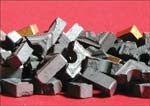Reduce Waste And Increase Efficiency With Carbide Recycling
As a cost-saving measure and to comply with environmental considerations, many shops turn to recycling programs for scrap and worn tooling. With increasing consumption of non-renewable raw materials and to help counteract the effects of high carbide prices, some manufacturers are providing recycling programs to help companies increase productivity and efficiency.
As a cost-saving measure and to comply with environmental considerations, many shops turn to recycling programs for scrap and worn tooling. With increasing consumption of non-renewable raw materials and to help counteract the effects of high carbide prices, some manufacturers are providing recycling programs to help companies increase productivity and efficiency. Many companies see these programs as a win for all involved.
In a typical recycling program, used hard-metal items are collected in a central location at a shop. Once full, the collection container is shipped to the company organizing the recycling program. The items are then sorted and recycled in the most environmentally friendly way. These programs contribute greatly to reduction of waste and better use of resources.
One company that has found success with the new structure of its carbide recycling program is Kennametal Inc. (Latrobe, Pennsylvania). “We’ve endorsed and practiced carbide recycling for a long time, but it wasn’t as systematic or efficient as it could be,” explains Pankaj Khare, senior product manager. By comparison, the current carbide recycling program launched in July, 2005, is very straightforward and easy to use. It also is Web-enabled, so large and small shops around the world have direct program access.
For Kennametal, carbide recycling “completes the loop in supply-chain efficiency for the customer while emphasizing ease of use for increased participation,” Mr. Khare says. At www.kennametal.com/carbiderecycling, customers can locate the latest rates for used carbide. After completing and submitting an online form, users can print a shipping label and send the materials to the company with a confirmation number. Qualified used carbide includes mixed coated and uncoated metalcutting inserts, free of chips, oil and steel contamination. Material must be free of braze. The carbide is shipped in closed containers not to exceed 1,000 pounds.
Benefits of the recycling program include cash back, invoice reduction or new tooling, depending on the customer’s needs. Mr. Khare describes the first phase of the program as being exceptionally well-received by Fortune 500 companies and smaller operations alike. He says Kennametal strives to provide total tooling solutions while setting an example for good environmental stewardship around the world, and the recycling program is representative of these efforts.
Related Content
-
Making Micro Threads
Production of micro threads can be challenging, but using the most suitable tools for a given application can simplify the task.
-
Data Matrix Codes Offer Cutting Tool Traceability
A company’s quest to discover errors in a manufacturing process has led to printing data matrix codes on its cutting tools that provide a wealth of information for both the user and this cutting tool manufacturer.
-
Micromachining Fundamentals
A number of elements must come together to establish an effective process for machining at a micro level. Here we consider four.















.png;maxWidth=300;quality=90)


